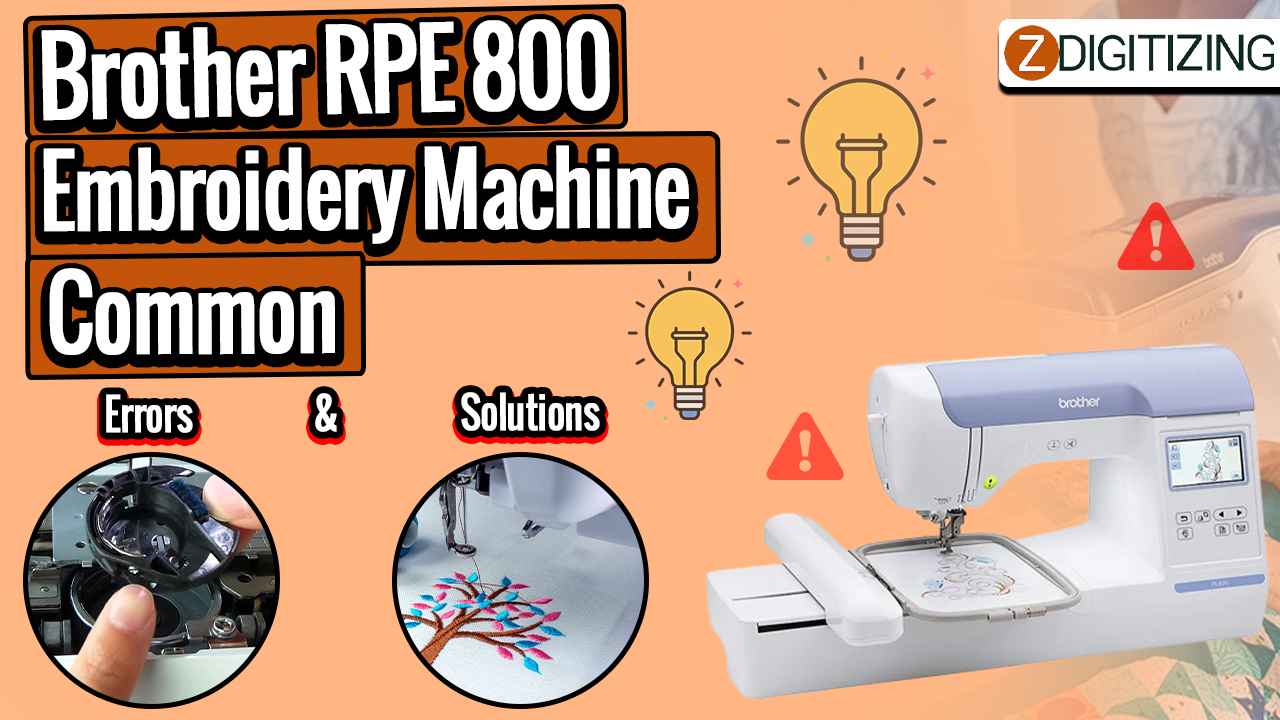
Brother RPE 800 Embroidery Machine Common Errors & Solutions To Maintain
Embroidery machines have transformed the world of crafting and design, making intricate embroidery projects more accessible than ever before. Among the various embroidery machines available, the Brother RPE 800 is a popular choice for both beginners and professionals. However, like any piece of equipment, it is not immune to errors and issues that can disrupt your embroidery projects. In this blog post, we will explore some common errors that users of the Brother RPE 800 embroidery machine may encounter and provide practical solutions to help you maintain and enjoy smooth operation.
Introduction to the Brother RPE 800
The Brother RPE 800 embroidery machine is known for its user-friendly features and impressive digitizing for embroidery capabilities. It offers a wide range of design options, customizable features, and intuitive controls, making it a valuable tool for those passionate about embroidery.
However, even the most reliable machines can run into issues from time to time. Let’s delve into some common errors associated with the Brother RPE 800 and how to troubleshoot them.
Common Error 1: Thread Breakage
Cause: Thread breakage is a frustrating issue that can disrupt your embroidery project. It may occur due to various factors, such as using old or low-quality thread, incorrect threading, or excessive tension.
Solution:
- Ensure you are using high-quality embroidery thread suitable for the machine.
- Double-check the threading process. Make sure the thread passes through all the guides and tension discs correctly.
- Adjust the tension settings based on the thread and fabric you are using.
- Keep the machine and thread path clean to prevent lint buildup, which can cause breakage.
Common Error 2: Needle Breakage
Cause: Needle breakage is another common issue that can halt your embroidery process. It can happen when the needle encounters resistance, such as a thick fabric or an improperly placed hoop.
Solution:
- Choose the appropriate needle type and size for your fabric and design.
- Ensure the fabric is securely hooped to prevent any resistance.
- Check for any obstructions in the needle path and remove them.
- Replace the needle regularly, as a dull or damaged needle is more likely to break.
Common Error 3: Bird’s Nesting (Bobbin Thread Tangles)
Cause: Bird’s nesting occurs when the bobbin thread tangles underneath the fabric, resulting in a messy, knotted appearance on the back of your dst embroidery file.
Solution:
- Re-thread the bobbin correctly, making sure the thread unwinds in the right direction.
- Verify that the bobbin tension is correctly set.
- Ensure the upper thread is threaded properly, with the presser foot raised.
- Use the appropriate stabilizer to prevent fabric puckering, which can lead to bird’s nesting.
Common Error 4: Uneven or Skipped Stitches
Cause: Uneven or skipped stitches can be frustrating and may result from issues like improper tension, a dull needle, or a damaged bobbin.
Solution:
- Adjust the upper thread tension as needed for your specific project.
- Replace the needle regularly to maintain its sharpness.
- Check for any bobbin issues, such as incorrect placement or damage.
- Ensure the machine is properly cleaned and lubricated to prevent friction-related issues.
Common Error 5: Machine Jamming
Cause: Machine jamming can occur when fabric or thread gets stuck in the machine’s moving parts, leading to a halt in embroidery.
Solution:
- Stop the machine immediately if a jam occurs to prevent further damage.
- Carefully remove the fabric and thread causing the jam.
- Inspect the machine for any loose threads or debris and clean it thoroughly.
- Resume embroidery once you are confident the issue has been resolved.
Regular Maintenance Tips
Aside from troubleshooting common errors, regular maintenance can help prevent issues from arising in the first place. Here are some maintenance tips for your Brother RPE 800 embroidery machine:
-
Clean the Machine: Keep the machine clean from dust, lint, and thread remnants. Regularly remove the throat plate and bobbin case for cleaning.
-
Oil the Machine: Follow the manufacturer’s guidelines for oiling the machine’s moving parts to ensure smooth operation.
-
Change Needles: Replace needles frequently, especially when you notice decreased stitching quality or needle damage.
-
Thread Quality: Use high-quality embroidery thread suitable for your machine to minimize thread-related issues.
-
Regular Servicing: Consider getting your machine professionally serviced annually or as recommended by the manufacturer.
In conclusion, while the Brother RPE 800 embroidery machine is a reliable tool for embroidery enthusiasts, it’s essential to be prepared for common errors that may arise during use. By following the solutions and maintenance tips outlined in this blog post, you can ensure that your machine continues to produce beautiful and flawless embroidery designs. Happy embroidering!
FAQs
-
How often should I change the embroidery needle on my Brother RPE 800 machine?
- It’s recommended to change the needle after every 8-10 hours of embroidery or whenever you notice decreased stitching quality.
-
Can I use any brand of embroidery thread with the Brother RPE 800?
- While you can use different brands, it’s advisable to choose high-quality embroidery thread that is compatible with your machine to avoid thread-related issues.
-
What should I do if my Brother RPE 800 keeps jamming frequently?
- If jamming occurs often, perform a thorough cleaning of the machine and ensure proper thread tension and needle condition.
-
How do I adjust the upper thread tension on the Brother RPE 800?
- Refer to your machine’s user manual for specific instructions on adjusting thread tension. Typically, there is a tension dial or digital setting that can be adjusted.
-
Is professional servicing necessary for my embroidery machine, and how often should it be done?
- Professional servicing is recommended annually or as advised by the manufacturer to ensure the machine’s longevity and optimal performance.



